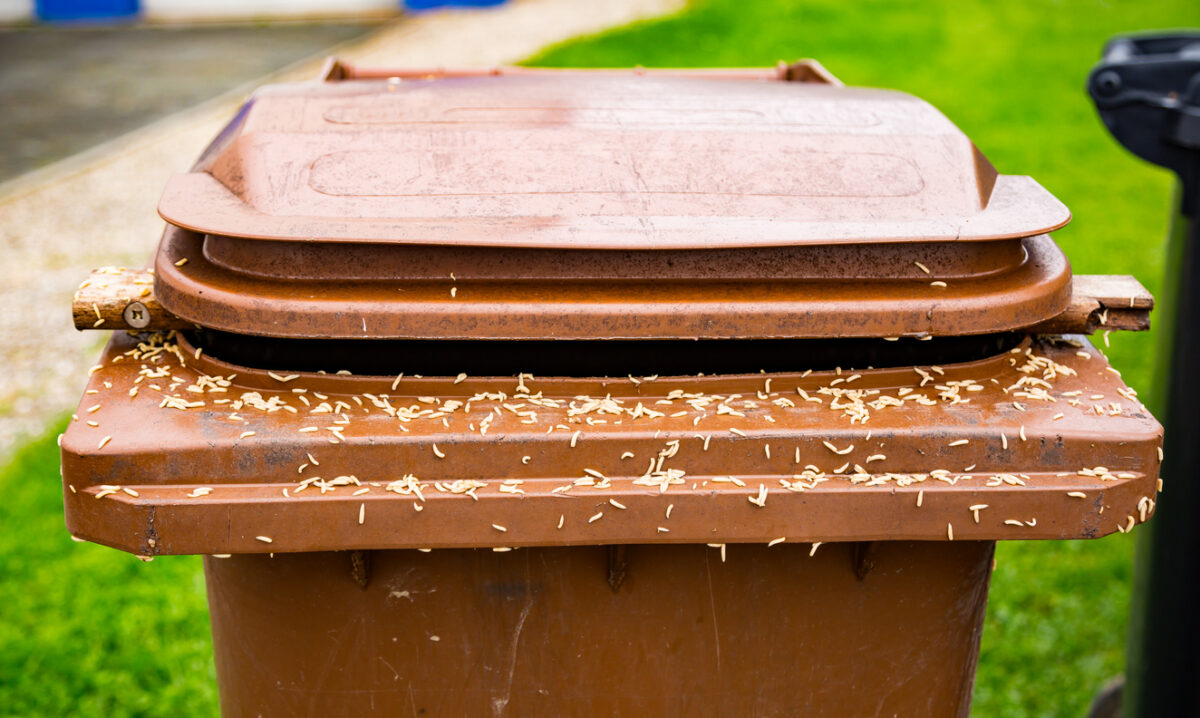

We may earn revenue from the products available on this page and participate in affiliate programs. Learn More ›
The presence of maggots is a dreaded sight for homeowners unlucky enough to have attracted them. These slimy white worms are actually fly larvae, and they’re quiet invaders you likely won’t discover until they hatch. Maggots are a common problem in warmer months, and as long as there are flies around, there’s the potential for a maggot infestation.
Maggots need to be eliminated quickly before they spread. Fly larvae transition into pupae after a period of about 5 days. These pupae then turn into adult flies, which breed and lay eggs that hatch more maggots.
To learn how to get rid of maggots, keep reading. We’ll explain how to kill maggots naturally.
How to Identify Maggots
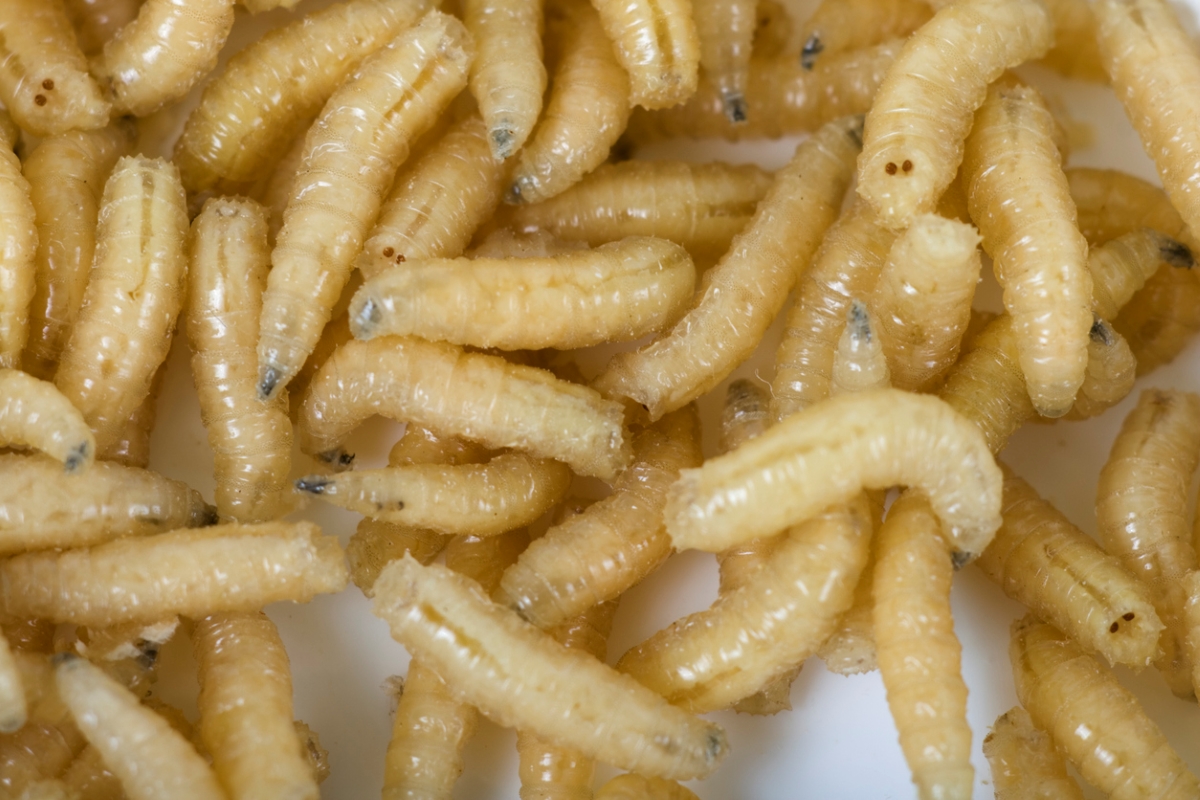
Many people describe maggots as small white worms, but fly larvae can also be light-brown in color. Usually no more than 1 inch long, maggots have one blunt end and one pointed end. The blunt end is the posterior, and can display two dark spots—these aren’t eyes, they’re the maggot’s breathing holes. The tapered side is the anterior end, or the head, which has a tube-like mouth and two small hooks. The mouth shape is generally how pest control experts from the best pest control companies (such as Orkin or Terminix) identify which fly species maggots belong to.
Maggots are most often found wriggling around in food, carcasses, or filth. Identifying them as fly larvae helps ensure use of the right pest-control method, and the areas in which these pests are found can help confirm they are indeed maggots. When in doubt, the University of Kentucky has a great resource for recognizing insect larvae.
RELATED: How to Get Rid of Pantry Moths
Where Do Maggots Come From?
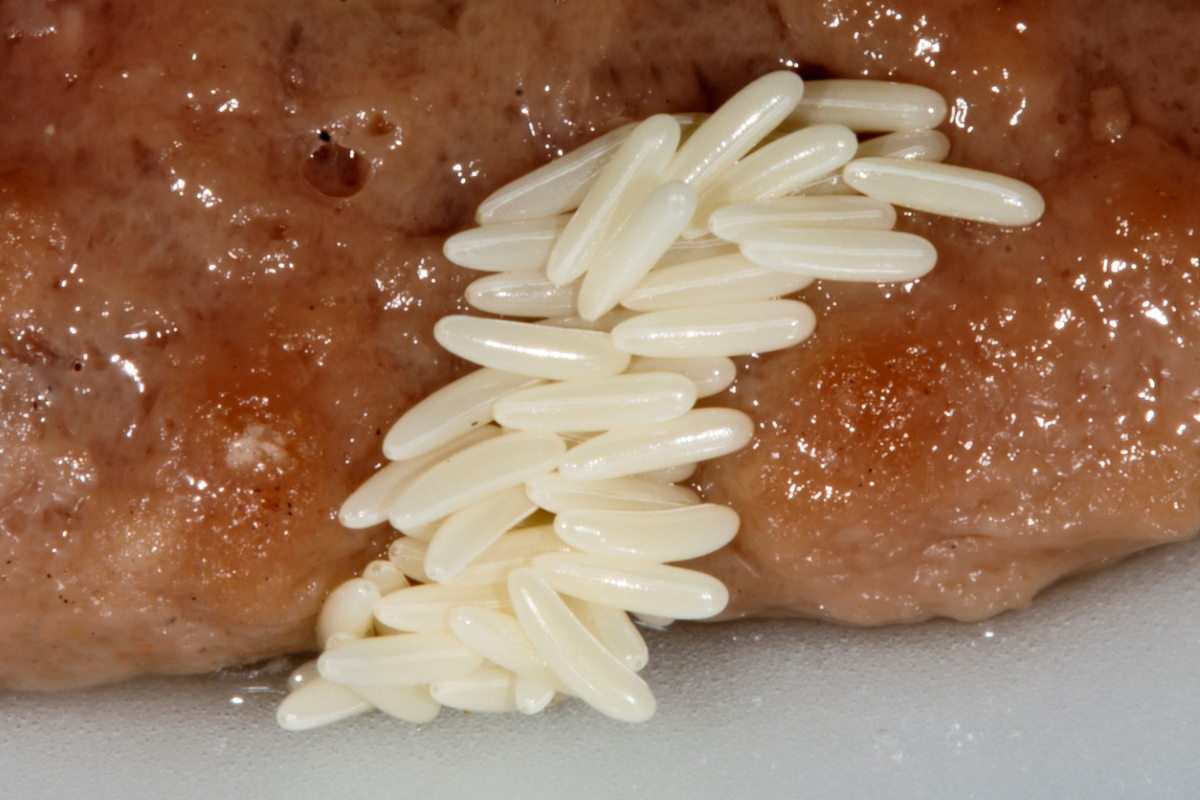
Maggots come from the eggs of several fly species in the Diptera order. Locations where maggots appear are breeding grounds for flies. Female flies usually lay around 150 eggs at a time. These eggs resemble small grains of rice and hatch into maggots within 24 hours. Maggots require wet environments with decaying matter—like rotten or spoiled food—which they feast upon after emerging from their eggs.
Maggots often hatch, grow, and develop in:
- Wet or moist environments, which prevent them from becoming dehydrated and drying out.
- Warm or hot environments, which speed up their development, helping them become adult flies much faster.
- Dark environments, since too much light can be deadly to maggots. These larvae use special light-sensing cells on their bodies to keep them away from well-lit areas.
In a home, yard, or garage, there are many attractive places for flies to lay their eggs. Maggots flourish around rotting food, decaying matter, or organic material, which explains why people find maggots in trash cans, unwashed food cans, spoiled fruit, compost piles, pantries, garbage disposals, pet excrement, and messy rooms.
Are Maggots Dangerous to People or Pets?
Flies are known to spread some diseases, but there is no strong evidence to suggest that the presence of maggots causes health problems in people.
In fact, some hospitals practice maggot therapy, wherein medical professionals use special maggot species to remove bacteria from infected wounds. Keep in mind, though, these are particular maggots bred for medical purposes—they are very different from maggots in a trash can. The maggots found in or around a home are likely contaminated with bacteria. Accidentally eating maggots or food that’s infested by them can cause bacterial infections or food poisoning.
Sometimes, flies deposit their eggs in or near an open wound of a person or animal, but this is most common among wild animals. As the maggots develop in the tissues of living organisms, an infection called myiasis may occur.
RELATED: How to Get Rid of Carpet Beetles and Carpet Beetle Larvae
How to Get Rid of Maggots Naturally
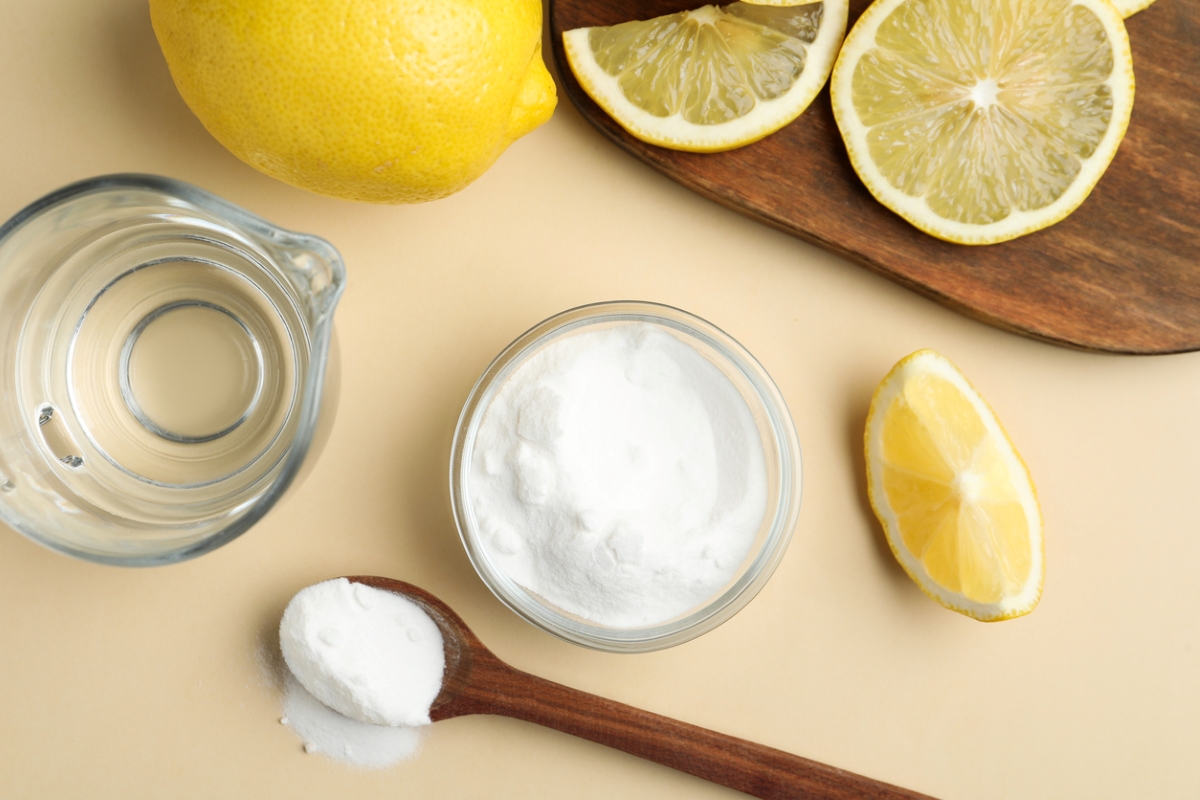
Insecticides and bleach are two ways to get rid of maggots, but there are natural pest control alternatives that eliminate maggots without harmful chemicals. What kills maggots naturally? There are many items that can be found in most homes that can treat maggots.
Here are five natural ways to get rid of maggot infestations.
Citrus Juice or a Vinegar Solution
An acidic liquid like vinegar or pure citrus juice makes for an effective maggot killer, as maggots can’t survive in acidic environments. Pour a generous amount of undiluted lime or lemon juice or a mixture of three parts hot water and one part vinegar directly onto maggots for quick results.
Allow the acidic liquid to sit for an hour or so before discarding the maggots in a plastic bag and then cleaning and sanitizing the area. You may have to repeat the process to take care of any unhatched eggs. An additional perk of this method is that these products also help eliminate the smell that attracted flies to the area in the first place.
Table Salt
Like other organisms, maggots need water to survive. It’s no secret these larvae need moist or wet environments to thrive, and salt is a natural dehydrator. Maggots will dehydrate and expire if they are sprinkled with salt.
Douse a maggot infestation in a large amount of table salt, and leave the area to dry out for about an hour. This is one of the most effective natural ways to get rid of maggots. After an hour, dispose of remaining maggots and eggs in a plastic bag and thoroughly wash and sanitize the infested area.
Boiling Water
A quick way to kill maggots is by using boiling water. Put a pot or tea kettle on the stove, bring the water to a slow boil, then pour it over a maggot infestation. This should immediately kill exposed maggots. This method is best for spots where the boiling water is less likely to spill or warp soft plastics—making boiling water a suitable way to kill maggots in a garbage disposal or trash can. The process might need to be repeated a few times to fully address all of the maggots and unhatched eggs.
Relocation
While less conventional, this natural method for getting rid of maggots can still be effective. In the wild, many birds, frogs, lizards, spiders, and other creatures eat maggots as a source of protein, and this can be used to your advantage.
If your maggot infestation is in a container or bin, move it to an outdoor space well away from your home where animals that eat maggots commonly hunt. Birds and other natural predators of maggots should quickly pick through the larvae. Once the maggots are gone, deep clean the bin to keep future maggots away.
Diatomaceous Earth
Diatomaceous earth is a natural powder made from the fossilized remains of small aquatic organisms. When maggots are sprinkled with diatomaceous earth, the powder sticks to their exoskeletons and dries them out. Just like salt, this powder dehydrates and kills maggots.
This natural maggot treatment is great for fibrous areas like carpet. Cover the maggots with diatomaceous earth, and wait approximately an hour. Sweep up what you can and vacuum up the rest, making sure to properly dispose of any maggot remains in the trash. Finally, deep clean the area to prevent maggots from coming back.
Tips for Preventing a Maggot Infestation
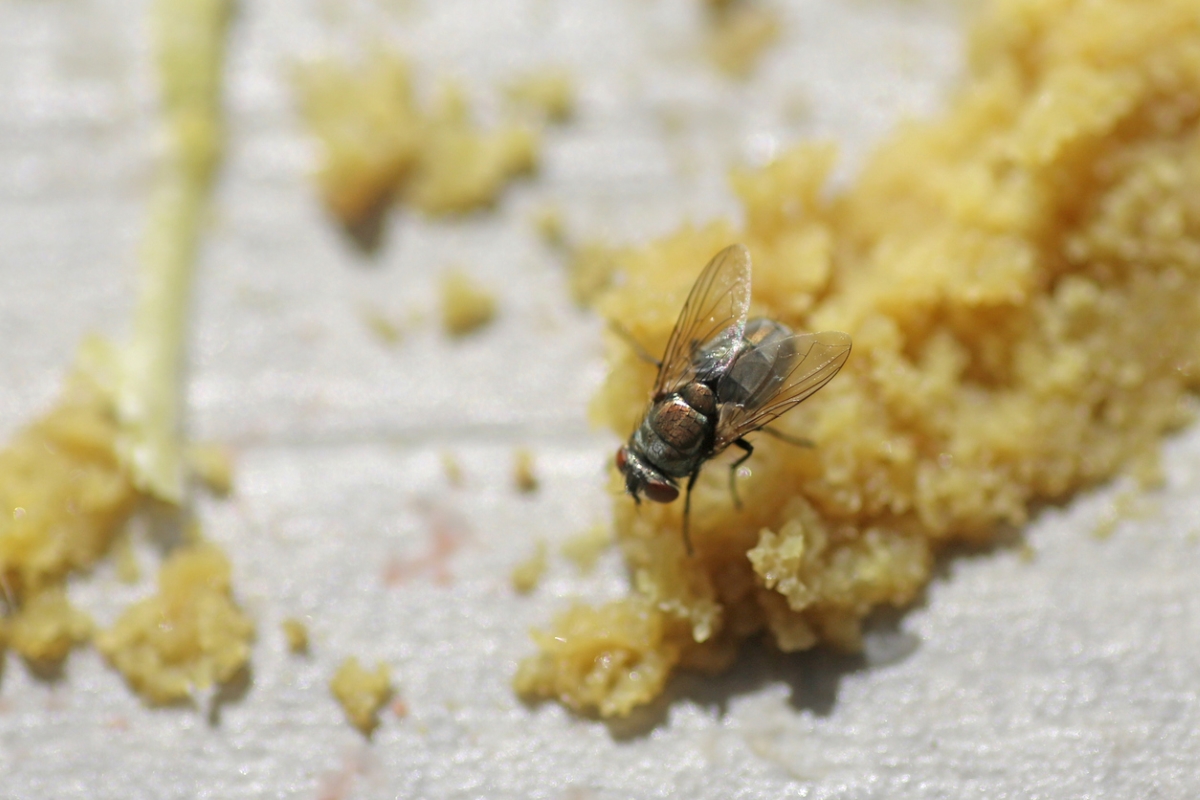
The best way to prevent maggots from showing up is to keep areas clean and prevent flies from making themselves at home. If there are any holes in window screens or cracks where flies can come in, get them fixed to keep flies outdoors. Small, consistent efforts go a long way to ensuring flies and their larvae don’t show up indoors.
Small habits, such as putting leftovers into sealed containers and washing dishes daily, prevent maggots from appearing on uneaten food. Make sure to clean the garbage disposal weekly. And any food that goes into the garbage can or compost bin should be taken out frequently to outdoor bins and bags with lids that seal properly.
Speaking of bins, cleaning them out with vinegar and water is a great way to keep them maggot-free. In outdoor compost piles, bury the food scraps and add 2 to 4 inches of paper, cardboard, or dried leaves over nitrogen sources—which attract flies.
Final Thoughts
Maggots don’t appear out of nowhere. If there are flies in or around a home, there’s the potential for those flies to lay eggs that turn into maggots. Putting in the effort to remove environments where flies can breed helps prevent maggots from hatching on the property.
Anyone who comes across a maggot infestation can try one of these five natural methods for killing maggots; any one of them should do the trick. Once the maggots are dead and cleared away, it is important to deep clean and disinfect the area to remove any bacteria and make it less desirable as a fly breeding ground.
RELATED: 30 Things in Your House That Are Attracting Bugs and Rodents
FAQs
Learning how to get rid of maggots is helpful knowledge to have, but hopefully it’s not something most have to implement. Armed with tips on what kills maggots, a few questions about fly larvae and how to deal with them may remain. Here are some of the most frequently asked questions and answers about how to get rid of maggots.
Q. What kills maggots instantly?
Boiling water is a natural method to kill maggots instantly. Pour the water carefully to avoid burns or spilling in other areas by mistake.
Q. Is there a spray that kills maggots?
There are several insecticide options that kill maggots, but these chemical sprays may not be the healthiest to use inside a home. Instead, use a spray of one part vinegar to three parts hot water to get rid of maggots.
Q. How long do maggots live?
Maggots live for an average of 5 days before turning into pupae and, eventually, adult flies.
Q. What causes maggots in the house?
Female flies lay their eggs in moist environments with organic, decaying, or rotting materials. Homes where old food, trash or compost bins, or similar conditions are accessible to flies are likely to attract maggots.
Q. Can maggots climb walls?
Maggots are burrowers, using the hooks on their anterior end to eat and move through material. There are anecdotal claims of maggots climbing walls, but this isn’t typical maggot behavior.
